
What is a Sailboat Boom Vang?

Last Updated by
Daniel Wade
June 15, 2022
A boom vang is a set of blocks and lines or an adjustable pole used to pull the boom down and shape the sail.
The boom vang (or “kicking strap”) is a system used to control the shape of the sail. It counteracts the upward force of the boom jack and the mainsail by pulling the boom downward. This results in the ability to control the shape of the sail.
Table of contents

Boom Vang vs. Mainsheet
What's the difference between the boom vang and the mainsheet? On many sailboats, the boom vang and the mainsheet look similar, as both use a set of blocks to control the motion of the boom.
The easiest way to tell the difference between the boom vang and the mainsheet is location. The boom vang typically begins close to the base of the mast and connects to the base of the boom at about a 45-degree angle.
The mainsheet is much further back and generally vertically-oriented. Sometimes, the mainsheet is located far at the end of the mast and connected to the stern of the vessel. Just remember boom vang forward, mainsheet aft.
What Does a Boom Vang Do?
A boom vang is a simple device consisting of a pole or a set of blocks and lines. The primary purpose of the boom vang is to control the vertical orientation of the boom and to exert a downward force on it.
Without the boom vang, the wind would blow the sail uncontrollably and make it difficult to maneuver efficiently. The mainsheet, which appears to exert downward pressure on the boom, wouldn't be able to adjust the sail effectively without a separate system like a boom vang.
Importance of the Boom Vang
A properly-adjusted boom vang becomes more important as you let out the mainsheet. The further from the centerline the boom travels, the less downward force the mainsheet provides.
This means that you'd lose a tremendous amount of control without a boom vang, especially as you loosen the sheet. A boom vang exerts a constant downward force on the sail regardless of what position the boom is in. This keeps the sail shape consistent in all conditions.
Boom Vang Types
There are two primary types of boom vangs used on sailboats today. The first and most common type is the standard boom vang. Standard boom vangs consist of a block and tackle arrangement that mounts to the base of the mast and bottom of the boom.
The second type is the hydraulic boom vang , which is more advanced and offers unique benefits. The hydraulic boom vang uses a hydraulic piston that looks like an oversized automobile shock or door opener.
The benefit of a hydraulic boom vang is that it holds the vertical position of the boom without assistance. It's rigid in both directions and doesn't require upward force to keep the boom in place.
Hydraulic boom vangs are costlier than traditional block-and-tackle setups. That said, they're easy to install and generally simple to operate. Hydraulic boom vangs are common on newer sailboats, especially those that exceed 30 feet in length.
What is a Boom Gnav?
A boom gnav is one of the most intuitive pieces of sailboat equipment. The word "gnav" is "vang" spelled backward, and it performs the exact same task on the opposite end of the boom.
A boom gnav exerts a downward force on the boom to counteract the upward force of the wind or rigging. A boom gnav pushes the boom down, whereas a boom vang pulls it down. Not all sailboats have a boom gnav, and those that do often use it as a substitute for a boom vang.
Boom gnav systems are most common on small sailboats , where the added lower triangle of a boom vang gets in the way. A boom gnav takes up no extra cockpit space as it mounts atop the boom and to a higher point on the mast.
In other words, the boom gnav operates within the sail area, which is a part of the boat that's already unusable due to the sail. A boom gnav is usually a pole that adjusts by sliding forward and aft on the boom, which changes the angle and downward force.
Boom Vang Maintenance
Maintenance is essential to keep your sailboat in safe and working condition, and the boom vang is no exception. There are a few boom vang parts you should inspect and maintain regularly.
Check the Mounting Points
The mounting points of the boom vang are subjected to a considerable amount of force, and they should be inspected regularly. Look for signs of corrosion (galvanic or otherwise) and bending.
If you notice any deformation, replace the mounting points and hardware with marine-grade hardware. Make sure the aluminum mast is solid, as corrosion can weaken the areas around the mounting holes.
Inspect Blocks and Tackle
For traditional boom vangs, regularly inspecting the blocks and lines can prevent problems down the road. Over time, nylon lines become salt and sun-damaged and begin to fray. If the lines are brittle and leave excessive dust on your hands, it may be time to replace them.
Blocks are generally reliable and don't require a significant amount of maintenance. That said, you should inspect your blocks and make sure they spin freely. If they don't (or they become too loose), they could be failing and should be replaced with high-quality marine blocks.
Hydraulic Boom Vang Maintenance
Hydraulic boom vangs are simpler than traditional block and tackle setups, but they still require regular inspection. A hydraulic boom vang uses a piston and a working fluid instead of lines and pulleys.
On hydraulic boom vangs, the primary failure points are the seals and the mounting points. If your boom vang begins to leak, you'll notice a decrease in stability, and the vang won't hold tension.
Another common failure point is the spring, which can weaken or break and make the vang almost unusable. In most cases, the best option when your hydraulic boom vang fails is to replace it entirely.
What is a Boom Jack?
A boom jack (also known as a lazy jack) is the rigging that exerts an upward force that the boom vang or boom gnav counteracts. The boom jack begins at the boom and reaches up to the top of the mast.
Boom jacks resemble any other rigging on a sailboat. They roughly form the triangular shape of the sail and usually mount to the boom at multiple points.
A typical boom jack begins as a single line at the top of the mast. About 1/4 of the way down the mast, it splits into two lines. At the halfway point, each end of the two lines splits again into four. These four lines run down to the boom and mount evenly-spaced apart.
The purpose of the boom jack is to exert even upward force on the boom. The tension of the boom jack is set as to counteract the tension of the boom vang, which holds the boom at a steady 90 degrees. The boom jack line runs down from the top of the mast to a block or cleat on the opposite end of the boom vang.
Adjusting the Vang
Generally speaking, the boom vang isn't as important when traveling upwind as it is when traveling downwind. This is especially true once you've maxed-out your mainsheet traveler.
At this point, the vang controls the twist of the mainsail. With an improperly-adjusted vang (or lack thereof), you could experience a lot of up-and-down play of the boom. This can cause you to lose control of the mainsail.
A properly-adjusted boom vang can help you keep your mainsail shaped correctly and keep your boom in the proper position. It also gives you precise control of your speed when traveling downwind.
Related Articles
I've personally had thousands of questions about sailing and sailboats over the years. As I learn and experience sailing, and the community, I share the answers that work and make sense to me, here on Life of Sailing.
by this author
Sailboat Parts
Learn About Sailboats
Most Recent

What Does "Sailing By The Lee" Mean?
October 3, 2023

The Best Sailing Schools And Programs: Reviews & Ratings
September 26, 2023
Important Legal Info
Lifeofsailing.com is a participant in the Amazon Services LLC Associates Program, an affiliate advertising program designed to provide a means for sites to earn advertising fees by advertising and linking to Amazon. This site also participates in other affiliate programs and is compensated for referring traffic and business to these companies.
Similar Posts

Affordable Sailboats You Can Build at Home
September 13, 2023

Best Small Sailboat Ornaments
September 12, 2023

Discover the Magic of Hydrofoil Sailboats
December 11, 2023
Popular Posts

Best Liveaboard Catamaran Sailboats
December 28, 2023

Can a Novice Sail Around the World?
Elizabeth O'Malley

4 Best Electric Outboard Motors

How Long Did It Take The Vikings To Sail To England?

10 Best Sailboat Brands (And Why)
December 20, 2023

7 Best Places To Liveaboard A Sailboat
Get the best sailing content.
Top Rated Posts
Lifeofsailing.com is a participant in the Amazon Services LLC Associates Program, an affiliate advertising program designed to provide a means for sites to earn advertising fees by advertising and linking to Amazon. This site also participates in other affiliate programs and is compensated for referring traffic and business to these companies. (866) 342-SAIL
© 2024 Life of Sailing Email: [email protected] Address: 11816 Inwood Rd #3024 Dallas, TX 75244 Disclaimer Privacy Policy

By Product Categories
Small Boat Blocks
Big Boat Blocks
Complementary Hardware
Travelers & Genoa Leads
Mainsail Handling
Headsail Handling
Mooring Solutions
Spare Parts
Accessories
Harken Canvas
Sportfishing
Fly Soft-Attach Blocks
Carbo Air Blocks
Small Boat Classic
Flip-Flop Small Boat
GP Catamaran Ceramic Mainsheet Systems
Protexit™ Exit Blocks
Through-Deck
Wire High-Strength
Dinghy Vang
Small Boat Deck Organizers
Midrange Classic
Midrange Deck Organizers
Zircon Blocks
Element Blocks
Black Magic Air Blocks
Cruising ESP Blocks
Megayacht Blocks
Stainless Steel Blocks
Black Magic Air Runners
FlatWinder Powered Blocks
Mastbase Blocks
Over-the-Top
Crossover Blocks
Big Boat Deck Organizers
Cam Cleats & Kits
Cam Cleat Accessories
Cam Cleat Bases
Stand-Up Bases
Deck Organizers
Spinnaker Pole Cars
Soft Attachments
Fixed Padeyes
Removable Padeyes
Bolt-Down Fairleads
Grand Prix Jib Leads
Halyard Tensioners
Tiller Extensions
Peter's Desk Drawer
Dinghy Jib Leads
Crossbow Pivoting Self-Tacking Jib Traveler
13 mm Micro
22 mm Small Boat
27 mm Midrange
32 mm Big Boat
Windward Sheeting
42 mm Mini-Maxi
T-Track Genoa Lead
Access Rail System
13 mm AA Battcar System
22 mm A Battcar System
27 mm B Battcar System
32 mm C Battcar System
18 mm Switch Battcar System
26 mm Switch Battcar System
26 mm Trysail Switch
32 mm Switch Battcar System
32 mm Trysail Switch
40 mm Switch Battcar System
40 mm Trysail Switch System
Furling Mainsail Outhaul Systems
Single Line Reefing
Harken Vang-Master
Carbo Racing Foil
Small Boat Furling
Small Boat Underdeck
Reflex Furling
MKIV Jib Reefing & Furling
MKIV Underdeck Jib Reefing & Furling
Furling Accessories
Powered Furling
MKIV Ocean Furling
SnubbAir (Not a Winch)
Grand Prix Winches
Air Winches
Circuit Breakers
Analog Switches
Digital System Switch
Aluminum, Chrome & Bronze Winch Handles
Carbo OneTouch Locking Winch Handle
Service Kits
CLR Mooring Winches
Electric Captive Reel Winches
Hydraulic Captive Reel Winches
UniPower Radial
Single-Acting Integral Backstay Adjuster
Single-Acting Cylinders
Locking Cylinders
Double-Pull Cylinders
Grand Prix Cylinders
Hydraulic Cylinder Rod End Blocks
Hydraulic Cylinder End Fittings
Control Valves
Control Manifolds
Control Panels
Compact Control Panel
Rotary Pumps
Hydraulic Pump Handles
Power Systems
Repair Kits
Ball Bearings
Block Spare Parts
Traveler Cars
Furling Spare Parts
Winch Spare Parts
Winch Service Kits
Blockheads Gear
Promo & Gifts
Marine Grip
Blue Performance
Jeep/Truck tops
Garage storage
One-design Covers
Boat accessories
Canvas bags
By Type of Sailing
Dinghy / One-Design
Offshore Racing
Coastal / Day Cruising
Bluewater Cruising
Megayachts / Custom
Service Guide
Tech/Service
deck layouts
Data Sheets (SDS)
How to choose
System diagrams
Calculators
Reeving diagrams
Traveler Purchase Selection Guide
How to Choose
Testimonials
Hoister Videos
Request a Quote
Request Samples
Fabric details
Cover Styles
Canvas Videos
Contract Services
Materials and Components
Our Equipment
Contract Cut-and-Sew Project Spotlight
- Harken at the front
- Safety & Rescue
Support / Selection tools / System diagrams
Boom Vang Systems
The vang allows vertical adjustment of the boom, and is an extremely important tool to shape the main for speed. Tension the vang to tighten the leech, flatten the sail and bend the mast. Cruisers use the vang to keep the boom from rising when sailing downwind and abraiding the main.
Typical boat length: Small Boat: 22' - 28' (6.7 - 8.5 m) Midrange: 29' - 34' (8.8 - 10.4 m) Big Boat: 35' - 42' (10.7 - 12.8 m)
This simple 4:1 self-cleating vang is used on small dinghies.

| Double | — | — | ||
| Fiddle | — | — |
The basic 4:1 fiddle block vang is commonly used on dinghies and small keelboats.

| Double | ||||
| Fiddle |
8:1 Cascaded Fiddle
A doubling block increases the purchase of the vang to 8:1. The load on the fiddle blocks is halved so they can be used safely on larger boats.

| Single | ||||
| Fiddle | ||||
| Fiddle |
4:1 Cascaded Kicker
This rigid rod vang utilizes a simple 4:1 tackle. The rod also serves as a topping lift for the boom. Used on cruising and racing boats.

| Double | ||||
| Fiddle |
6:1 Double-ended Cascaded Kicker
Many racers rig the vang with a double-ended control line led down each side of the boat.

| Triple | ||||
| Double | ||||
| Single | ||||
| Cam cleat |
Product Categories
- United States
- New Zealand
- United Kingdom

The $tingy Sailor
Diy trailerable sailboat restoration and improvement without throwing your budget overboard.

Control Your Mainsail Shape Better With a Boom Vang
A boom vang is a useful control for your mainsail, especially if the mainsail is older and acting its age. That is, if it’s getting baggy and is difficult to flatten, particularly when you’re pointed off the wind. For better performance and safety, you need to be able to pull excess twist out of the mainsail and flatten the leech. The best way to do that is with a boom vang. It has the added benefit of preventing the end of the boom from raising so high during gybes that it can snag the backstay, a potentially dangerous situation if the wind is strong enough.
Before I continue, a bit of legal housekeeping. This post contains affiliate links. That means I receive a small commission if you make a purchase using those links. Those commissions help to pay the costs associated with running this site so that it stays free for everyone to enjoy. For a complete explanation of why I’m telling you this and how you can support this blog without paying more, please read my full disclosure .
How a boom vang improves mainsail shape
A boom vang is a tackle system attached at a 45° angle between the mast and the boom. Its purpose is to pull the aft end of the boom down when the mainsail is fuller and more twisted than desired. It can be used on any point of sail but is most useful on a reach. For this reason, the lower end of the vang is typically attached near the mast tabernacle so that the vang can rotate with the boom and keep equal tension on any point of sail.
Tightening the vang flattens the mainsail and provides more balance so that the headsail can be trimmed to make more forward power. Easing the vang allows the top of the mainsail to twist and spill air to avoid overpowering the rig. This technique is called vang sheeting and is an effective way to control heeling without adjusting the main sheet.
DIY materials list
You can spend hundreds of dollars on a pre-assembled kit or you purchase standard parts à la carte and save a lot.
What you’ll need:
- Two fiddle blocks , one (upper) with a becket and cam cleat. The other (lower) can be standard.
- Jaw snap shackles to attach to the ends of both fiddle blocks. These make the vang quick to attach and detach.
- Garhauer BT-2 boom tang or equivalent screwed to the boom
- Garhauer BB-2 boom bail or equivalent held by the mast step bolt. If your sailboat has a mast step plate with a vang loop built in, you can use that instead.
- 16′ x 5/16″ New England Ropes Sta Set , tied or eye spliced to the fiddle block becket, 30′ if you want to lead the line through a deck organizer with other lines from the mast.
Installation instructions
To install a boom vang on a C-22 or similar sailboat:
1. The vang should be installed at a 45 degree angle between the mast and boom. Measure the height of the top of the boom above the cabin roof with the mainsail at full hoist. For a Catalina 22, it should be 39″.
2. Measure the same distance along the bottom side of the boom from the aft side of the mast and make a pencil mark. This is where you will attach the boom tang.
3. Attach the boom tang so that it is angled toward the base of the mast as shown below. If the boom tang has straight legs, carefully bend them to fit the combination of the boom curvature and the tang angle. When the fit is good, drill 5/32″ pilot holes and use #10 x 3/4″ pan head stainless steel tapping screws. Leave enough space between the tang and the boom to connect a snap shackle as shown in the following picture.

4. If your sailboat does not have a mast step plate with a vang loop built in, remove the mast step bolt, align the boom bail holes with the mast holes, and replace the mast step bolt as shown in the following picture.

5. Attach the snap shackles to the fiddle blocks as shown in the preceding pictures.
6. Tie or splice one end of the line to the becket on the upper fiddle block.
7. Reave the line through the fiddle blocks and the cam cleat.
8. Use the snap shackles to connect the lower fiddle block to the bail and the upper fiddle block to the boom tang.
9. Test for smooth operation of the vang and that the boom rotates freely.
You can rig this boom vang in one of two ways. In its simplest form, the fiddle block with the cam cleat and the standing end of the line can hang over the companionway hatch and doesn’t need to be led farther aft. You or your crew can just reach up and trim it as needed.
You can also rig it with the line long enough to lead it aft with other running rigging. For that, lead the standing end outside of the cam cleat, down through a turning block at the mast base, over the cabin roof, through a deck organizer, then aft to a cleat over the bulkhead. The advantage of this setup is that it’s easier to trim on a reach when the boom is swung forward. It’s also easier if you have a bimini that is in the way of reaching the cam cleat.
The longer line also makes the vang more versatile as a utility tackle system. With its 4:1 mechanical advantage and quick release shackles, you can easily detach it and move it to wherever you need some heavy lifting or pulling power such as hauling up a crew member that’s fallen overboard.
To get full control of your mainsail, also see Flatten Your Mainsail Foot with an Outhaul and Control Mainsail Draft with a Boom Downhaul . All three controls work great in combination with each other to flatten the mainsail in medium to heavy winds.
For the complete collection of rigging projects like this one, purchase my ebook Do-It-Yourself Small Sailboat Rigging .

Would you like to be notified when I publish more posts like this? Enter your email address below to subscribe to this blog and receive notifications of new posts by email. You will also receive occasional newsletters with exclusive info and deals only for subscribers and the password to the Downloads page. It’s free and you can unsubscribe at any time but almost nobody does!
Subscribe to Blog via Email
Enter your email address to subscribe to this blog and receive notifications of new posts by email.
Email Address:
Share this:
16 thoughts on “ control your mainsail shape better with a boom vang ”.
You may find it more convienent to reverse the way you have your vang mounted in the pictures. By placing the cam at the mast base you can adjust vang tension at any boom position. Also, this would eliminate the need for a turning block if you do decide to run the line aft.
That’s a good point that I forgot about when I wrote this one. Thanks for noticing!
I’ve only read a couple of your solutions so fa, but I plan on reading them all! I’m already wondering where you find parts so inexpensive though. You reportedly completed this whole project for the price I would have to pay for a single snap shackle.
Ah, that’s what separates the ordinary sailboat owners from stingy sailors! If I had to pay normal retail prices, I couldn’t afford to own a boat. Check out The 6 best sources for sailboat parts and supplies for where I shop.
Fantastic! I will definitely be including ebay in my search from now on. Thanks so much!
Why or what advantage to using a tang on the boom instead of another bail? (Great article by the way.)
Good question!
You could theoretically use another bail but the attachment to the boom would be a challenge. The holes in the arms of the bail accept a 5/16″ fastener so that would either be oversize sheet metal screws going into the boom or if you used a through-bolt, you’d want to prevent compressing the boom cross-section. Either that or let the bail swing freely on the bolt, which is unnecessary.
The holes in the tang accept much smaller sheet metal screws that are more appropriate for the thin wall of the boom extrusion and because there are four holes, the tang can be solidly attached without allowing any movement.
The bail works ideal for the tabernacle connection since it lets the vang snap shackle slide side-to-side in an arc with the boom movement and without affecting vang tension. It fits perfectly over the tabernacle as you can se, and the mast bolt fits the bail as well. It’s also nice to be able to remove the bail for stepping the mast or to fold it out of the way.
Have you ever done a piece on how to string holiday lights? I looked on your site and couldn’t find one.
I haven’t written one yet, but I did string LED lights all over Summer Dance for the night-time boat parade this past 4th of July. Since she’s out of the water until spring, I won’t be doing it again for Christmas. I do need to raise the mast for another project coming up so maybe I’ll write this one too.
Stay tuned.
Over the years, I have participated in numerous lighted boat parades. The first one taught me not to put white “icicle” lights on the lifelines. Looking forward, I couldn’t see outside the lights. Had to position a crew member on the bowsprit for visual relays. Hang them from your tow rails along the hull.
Great article! Thanks!
GOOD STUFF STINGY! I learned something I will DEFINITELY incorporate in my sailing. I have an ’86 C22, and will be utilizing your advice for several projects!
Stingy, Thanks again for all the great articles!! What diameter mast step bolt do you have? I wanted to make sure I ordered the right Boom Bail and would like to configure like yours using the mast step bolt.
The C-22 mast and mast step accept a 5/16″ diameter bolt but I prefer a 1/4″. It’s easier to insert through the 6 holes of the bail, step, and mast while stepping the mast. It only acts as a pivot pin and isn’t subjected to much force at all so the reduced size isn’t a strength concern. But a 5/16″ bolt would work too.
Thank you and see how 1/4″ would make things easier to insert. Does the BB-2 accept a 5/16?
Yes, so you can use either size.
Leave a comment Cancel reply
This site uses Akismet to reduce spam. Learn how your comment data is processed .
- Already have a WordPress.com account? Log in now.
- Subscribe Subscribed
- Copy shortlink
- Report this content
- View post in Reader
- Manage subscriptions
- Collapse this bar
- New Sailboats
- Sailboats 21-30ft
- Sailboats 31-35ft
- Sailboats 36-40ft
- Sailboats Over 40ft
- Sailboats Under 21feet
- used_sailboats
- Apps and Computer Programs
- Communications
- Fishfinders
- Handheld Electronics
- Plotters MFDS Rradar
- Wind, Speed & Depth Instruments
- Anchoring Mooring
- Running Rigging
- Sails Canvas
- Standing Rigging
- Diesel Engines
- Off Grid Energy
- Cleaning Waxing
- DIY Projects
- Repair, Tools & Materials
- Spare Parts
- Tools & Gadgets
- Cabin Comfort
- Ventilation
- Footwear Apparel
- Foul Weather Gear
- Mailport & PS Advisor
- Inside Practical Sailor Blog
- Activate My Web Access
- Reset Password
- Customer Service

- Free Newsletter

Beneteau 311, Catalina 310 and Hunter 326 Used Boat Comparison

Maine Cat 41 Used Boat Review

Cheoy Lee Clipper 36 & 42 Used Boat Review

Aluminum Cruisers: The Basics for First-Time Buyers

Tillerpilot Tips and Safety Cautions

Best Crimpers and Strippers for Fixing Marine Electrical Connectors

Thinking Through a Solar Power Installation

How Does the Gulf Stream Influence our Weather?

Stopping Mainsheet Twist

Working with High-Tech Ropes
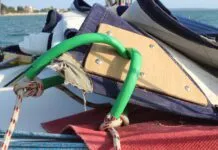
Getting a Clue for the Blown-Out Clew
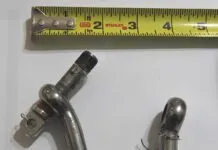
Monel Seizing Wire is Worth the Extra Cost

Fuel Lift Pump: Easy DIY Diesel Fuel System Diagnostic and Repair

Ensuring Safe Shorepower

Sinking? Check Your Stuffing Box

The Rain Catcher’s Guide

Mastering Precision Drilling: How to Use Drill Guides

Giving Bugs the Big Goodbye

Windlass Replacement on an Island Packet 40

Galley Gadgets for the Cruising Sailor

Those Extras you Don’t Need But Love to Have

UV Clothing: Is It Worth the Hype?

Preparing Yourself for Solo Sailing

How to Select Crew for a Passage or Delivery

Preparing A Boat to Sail Solo

On Watch: This 60-Year-Old Hinckley Pilot 35 is Also a Working…

On Watch: America’s Cup

On Watch: All Eyes on Europe Sail Racing

Dear Readers

Chafe Protection for Dock Lines
- Sails, Rigging & Deck Gear
Solid Vang Showdown
Vang master pushes to the top; steer clear of the ocean vang.

]It’s been more than six years since Practical Sailor evaluated rigid boom vangs. Given the rapid evolution of sailing hardware, it’s high time we take another close look.
In that May 15, 1999 report, we wrote that Hall Spars and Rigging’s QuikVang was the best all-around product, if you were game to ignore prices. Garhauer Marine’s vang was our Best Buy due to its rugged construction and economical price, and Spinlock’s then new Powervang was the product of choice for the racing set. If you owned a larger boat and wanted a lightweight vang, your best bet was Selden’s Rodkicker. As that 1999 test indicated, determining the appropriate rigid vang for your boat and your style of sailing is not a one-size-fits all affair. The process is fraught with conditional answers that only you can supply.
First, you have to determine if you want a rigid vang primarily for supporting your boom. If that’s the case, then the performance of the vang may be less important to you than the cost and the product’s purported longevity. If you want a vang that will allow you to make fairly precise refinements to your mainsail trim as well as support your boom, you’ll be looking more closely at how easy it is to adjust and its range of adjustability. Then, you have different types. Do you favor a spring-loaded, gas-cylinder, pneumatic, or rod vang?
Our evaluation included all four types. It’s important to note that you shouldn’t install a rigid vang on a boom that rotates, as this will compromise the gooseneck fittings on the vang or the boom itself. Also, standard, off-the-shelf rigid vangs like the ones PS evaluated here are not suitable for use with in boom furling. For those applications, you’ll want heavier duty equipment.
The Test For this test, PS amassed a group of eight rigid vangs from seven manufacturers. We asked each company to send a vang that would be suitable for a 36-foot sloop with a 13-foot boom. We told them that we were upgrading from a 4:1-purchase soft vang, that our objectives were convenience and safety, and stipulated that there were no suitable fittings on the mast or boom for attaching the new vang. We also mentioned that the mainsail on this boat weighed 50 pounds, and we described the spars as having rectangular grooves for the attachment fittings.
Selden Masts, which manufactures three different sizes of the Rodkicker, loaned us a mast and boom display mounted on a pallet, and we used this as a test platform for each vang. We looked closely at the vangs as well as the mounting fittings, which can vary according to the type of spar you have. We operated each vang multiple times and examined the construction quality, noted the stroke range, maximum return force, as well as the ease of use, and overall weight.
Vang Master Marine Products Engineering is a small manufacturing firm based in San Pedro, California, that also builds pneumatic actuators for doors, lids, and some other applications. Proprietor and designer Doug Grant has been building vangs for 14 years, and he is the supplier for Melges Boatworks and Ultimate Sailboats. His Vang Masters range in size from from 24 inches to 9 feet.
Grant uses 6061 T6 aluminum tubing that is hard-coat anodized and impregnated with Teflon. The end fittings are also machined from aluminum and hard-coat anodized. Except for the sheave and jaw attachment pins, MPE doesn’t use any stainless steel. These vangs operate with an 8:1 cascading purchase system using Harken blocks (including a ratchet block and cam cleat), the last part of which runs through a sheave in the upper end of the vang.
Grant says he presets the cylinder pressure on each vang, but he also includes a bicycle pump so that an owner can make his own adjustments. To change the pressure, you simply pump the vang up to whatever pressure you need to keep the boom level.
The lightest vang, the Vang Master also provided the smoothest action. This was surprising, because others like the Hall QuikVang or those from Garhauer come with greater mechanical advantage. The Vang Master VM-4 offers 16 to 18 inches of stroke range with up to 500 pounds of return force, and comes with a four-year warranty that covers any breakage under normal use. It sells for $845, including the pump, but not the end fittings ($110 for the boom, $145 for the mast).
Garhauer Marine Known for its rugged, if heavy, products, Garhauer Marine provides deck hardware for Catalina Yachts. The company supplied two vangs for our test: the RV20-1SL with a stainless outer tube, and the deluxe RV20-1AL, with a 6061 T aluminum outer tube, integrated purchase fittings, and a larger aluminum sheave in the head. Both vangs are intended principally to support the boom and both rely on 1½-inch diameter stainless steel springs — four in each case — to offer the resistance.
Garhauer includes in its price custom mast and boom fittings that are polished, beefy 316 stainless pieces with finely welded or machined components. The vangs featured similarly rugged construction. Except for the composite sheaves built into the vangs’ forked ends, all the sheaves in the 20:1 purchase are anodized aluminum, which spin on Torlon ball bearings.
These vangs have a wide stroke range — 8 to 12 inches — and they reliably returned our boom to the same position. Their construction appears to be bullet-proof (they carry a 10-year warranty) and they have the lowest prices of any vangs that passed our test ($374 for the RV20-1SL, and $429 for the duluxe RV20-1AL, including end fittings). Yes, they’re also the heaviest products, but not by much. Their main disadvantage is that, once they are installed, the resting height is not as adjustable as it is in other vangs.
Forespar Forespar’s Yacht Rod is made of a polished stainless steel inner tube and an Awl-Grip coated aluminum outer tube, and anodized aluminum forked ends. The Yacht Rod uses a single stainless steel spring for resistance. It’s marketed as both a device for supporting the boom and for trimming the sail in cruising or racing applications.
The Yacht Rod, which is built in three sizes, has a 4:1 tackle using Harken fiddle blocks and 7/16” line. A section of Spectra line attaches to that and runs through an aluminum sheave in the upper end’s fork to create an 8:1 purchase.
Forespar offers several sizes of mast and boom end fittings for its Yacht Rods (sold as part of the package or separately). The majority of these are fashioned from polished stainless steel. The welds on the fittings that were sent to PS were solid and well executed.
The outer tube has four holes at four-inch increments that accept a fast pin to adjust the boom’s height and allow a wide range of resting positions. This would be a handy feature to temporarily lift the boom in order to raise or lower a dodger or bimini. Forespar’s otherwise excellent installation instructions lacked a detailed drawing of the mast end, which would be a big help.
This vang was simple to install and operated fairly smoothly, but the spring did squeak slightly when compressed. The medium-size Yacht Rod has a stroke range of 7 inches, and provides 600 pounds of return force. It comes with a warranty of three years and sells for $873, including the tackle and end fittings.
Hall QuikVang Roughly five years ago, Hall Spars introduced the pneumatic QuikVang 2000, but, citing “complexities with its use,” has stopped production. Hall plans to introduce a new vang, which we’ll test and present in a future issue. For this evaluation, we looked at the conventional
QuikVang, a top performer in previous tests, and a product that Hall has been building for 20 years.
Marketed principally as a sail-trimming device, the QuikVang has anodized aluminum tubing and end fittings as well as a stainless steel spring. A Delrin plug in the inner tube acts as a piston to compress the spring when the 18:1 purchase system is tensioned. Delrin sleeves between the two tubes reduce friction and snug tolerances between the spring and the outer tubing keep the spring in column. Once installed, you can adjust the vang’s resting height in one-inch increments by loosening the set screws on the adjuster knob.
The purchase system features Harken blocks and Yale Dacron braided line, and includes a ratchet block and cam cleat so you don’t need any additional deck hardware for basic operation. Three parts of the purchase use stainless wire over aluminum sheaves, which are mounted in the jaws of the vang. Hall’s end-fittings are machined from aluminum and then hardcoat anodized.

The QuikVang was easy to install and adjust. It operated smoothly and reliably returned the boom to its initial position. One convenient feature is a ratchet that lets you release the control line under heavy load. And Hall’s booklet of instructions is very complete, including information on installation, operation, and maintenance. This model has a stroke range of 6 inches, 600 pounds of return force, comes with a three-year unconditional warranty, and sells for $906, not including end fittings.
Seoladair’s Boomkicker Seoladair, a small manufacturing firm just outside of Chicago, IL, produces stowable fenders, rolling boom bales, and the Boomkicker. This product is simple and will suit owners who want something to support their boom and work in tandem with an existing soft vang.
The Boomkicker, which is sold in five sizes for boats from 14 to 38 feet, is simply a set of fiberglass rods. The rods are held captive at either end with hardcoat anodized aluminum collars and attach to the mast and boom via durable, machined and anodized aluminum fittings. Users can further customize the Boomkicker by cutting the rods to a shorter length.
PS found the Boomkicker simple to install and easy to use. The 1500 we tested came accompanied by a 4:1 tackle using Harken blocks (and cam cleat) as well as a short section of Spectra run through an additional block to create an 8:1 purchase. Also included was an aluminum attachment tang for the purchase system, as well as a drill bit, stainless fasteners, and a tap to secure the fittings to the boom. (In most cases, the mast fitting uses the luff groove for attachment and no drilling or tapping is necessary.) At 4.5 pounds, the Boomkicker is the lightest in this test. The model we tested offers 600 pounds of return force with a stroke range of up to 16 inches, and carries a five-year warranty. It sells for $309, not including tackle, which we found for $173.
Last year, Seoladair introduced a new sliding boom fitting, which includes a 16-inch section of aluminum track and a car for the upper end. Without this, the Boomkicker drop outs out of the boom when it’s raised well above horizontal. This is to prevent overloading of the fittings. We’d definitely shell out the extra $108 for the new boom fitting.
Selden’s Rodkicker Selden’s Rodkickers come in four sizes for boats from 22 to 60 feet and use gas-pistons for their return force. These pistons are mounted inside rectangular anodized aluminum extrusions that are mated to anodized aluminum end-fittings secured with Monel rivets. This vang came with an external 4:1 block and tackle using Rutgerson fiddle blocks with a cam cleat, which Selden sells as an option. The tackle connects to a large stainless wire that runs over a composite sheave integrated into the vang’s upper end fitting, creating an 8:1 purchase.
We tested the Rodkicker 20, which is rated for boats from 35 to 42 feet. To specify its vangs, the company first looks at righting moment and rig type, and thereafter considers the weight of the boom and sail. The Rodkicker 20 claims a stroke range of seven inches and a return force of 876 pounds using the normal gas piston. The inner extrusion is capped by a composite plug, which acts as a bushing.
It took PS testers about 20 minutes to read the instructions and assemble the Rodkicker 20, which arrived in three boxes. It mounted easily to the machined boom (aluminum) and mast (stainless steel) fittings that the company supplied. The first time we used it, this vang took the most force (roughly 60 pounds) to compress, but it operated smoothly after that. Bernie Beasley at Selden told us that operation of each vang relies on the weight of a full boom and sail resting on it. With that factored in, he said, we wouldn’t have experienced as much initial resistance.
Selden offers a two-year warranty on the Rodkicker. The 20 sells for $685, not including tackle. We were impressed by several aspects of this vang. Where clevis pins are used to connect the vang to the boom and mast, the end fittings have recesses to keep the cotter pins from sticking out and doing damage. And the boom fitting uses three Allen screws for attachment. These can either be tapped into the spar or dogged down for compression attachment. Selden also offers a universal boom bale for booms without an integral track.
Sparcraft Based in France, Sparcraft has manufacturing facilities for mast, booms, and rigging systems there and in the United States at Charleston Spars in Charlotte, North Carolina. The Ocean Vang uses anodized aluminum tubes that compress a stainless steel spring by way of an external 4:1 purchase system to deliver a return force of 300 pounds The vang has sheaves integrated into its end fittings, and there are no external blocks, which simplifies the arrangement, but limits the amount of purchase available. (Some vangs are sold with additional external tackle.) The polished, 316 stainless-steel brackets for mast and boom come in various sizes and configurations.
Installation was simple and straightforward, which was good because the vang arrived with no instructions. You’ll need to lead the the control line to a swiveling, pivoting block mounted on deck because the sheaves in the vang don’t articulate and the line won’t otherwise lead in a fair fashion when the boom is off centerline.
PS found two problems with the Ocean Vang. Its spring was squeaky and it didn’t regularly return the boom to its initial point after we installed it. When we opened the unit, we found that the design doesn’t keep the spring in column. When the spring moves off-center — as is almost certain to occur any time the spring is under load — the spring rubs directly on the outer tube, producing friction and squeaking. We applied some WD 40 and the vang worked more smoothly and squeaked less, though it still didn’t perform satisfactorily.
Jim Kulibert, Charleston Spars’ director of sales, told us that our experience was an anomaly. He says the company has furnished hundreds of these vangs to boats over the years and they never receive complaints of squeaks or binding.

This size Ocean Vang retails for $279, which includes the control line, but not the brackets for the mast ($39) or boom ($42). The vang carries a one-year warranty.
Conclusions For cruising sailors, it’s most important that a rigid vang works to support the boom and secondarily to trim the mainsail. If simple support is what you’re after, almost all of these products are suitable. Factor in ease of operation, and you can whittle that group down by excluding the Sparcraft’s Ocean Vang, which we have given a Don’t Buy rating.
If post-installation adjustment is the next criterion, you can overlook the vangs from Selden and Seoladair, which worked perfectly well in all other aspects. So, you’re left with our selection of vangs from Garhauer, Forespar, Hall, and Marine Products Engineering (the Vang Master). The Garhauers offer limited adjustment pre-installation, the
Yacht Rod adjusts in 4-inch increments, the QuikVang in 1-inch increments, and the Vang Master’s range is virtually unlimited.
If you want a basic rigid boom vang that is well built and functions smoothly for the least dollar outlay, Garhauer is the clear choice. Astoundingly, these rugged vangs are about half the price of those from the other builders, and with a 10-year warranty, they are hands down our Budget Buy.
If you are interested in a smoothly operating vang that you can use to reliably control your mainsail, those from Forespar or Hall fit the bill and earn our Recommended rating. But of all the vangs, the Vang Master from Marine Products Engineering has the best adjustability, the smoothest operation, the longest stroke range, and the longest warranty of these three, and thus, even with it’s high pricetag, it is our Best Choice overall.
Also With This Article “Vang Types” “PS Recommended” “PS Value Guide: Boom Vangs”

RELATED ARTICLES MORE FROM AUTHOR
What issue did this article appear in?
The prices in this article are from 2006 /2019?? I’m interested in the Garhauser vang but see only these vangs and prices: Rigid Boom Vang RV20-1 DX => $679.80 Rigid Boom Vang RV20-1 SL => $599.50
LEAVE A REPLY Cancel reply
Log in to leave a comment
Latest Videos

The Boat From True Spirit – Sparkman & Stephens

Top 5 Boat Hacks – Boat Maintenance Tips and Tricks

Pearson 30 Sailboat Review

How To Change Your Sailboat Engine Mounts
Latest sailboat review.

- Privacy Policy
- Do Not Sell My Personal Information
- Online Account Activation
- Privacy Manager
Do I Really Need a Boom Vang?
November 7, 2017
We get a lot of great questions through our Ask the Expert portal and sometimes they make for great articles. Here are Quantum's David Flynn's insights for Mark A. and everyone else who's wondered about how to properly use the boom vang.
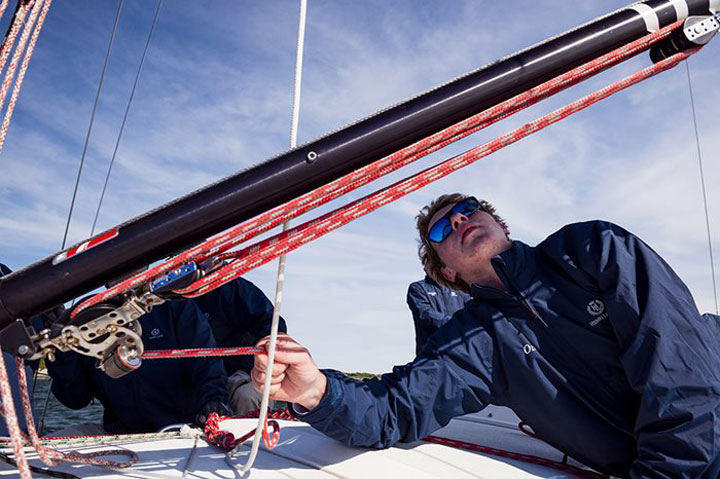
I’ve barely ever used my boom vang. Do I really need one?
Absolutely! The boom vang can be a misunderstood sail control. It takes over the job of pulling down on the boom once the mainsheet is eased. Upwind, the mainsheet pulls down as soon as the boom is over the traveler. Controlling the boom height determines twist, or the shape of the mainsail leech.
If you don’t use the boom vang in all but the lightest conditions, the boom will rise up as it is eased out and the sail will twist off, spilling power out of the top of the sail. This is okay when you have too much heel and helm, but not when you need power. Not taking advantage of your boom vang also limits how far out you can ease the sail. If the top is twisted off, it will run up against the upper shrouds and wrap itself around the stay, which prevents you from letting out the sail as far as you would like. The golden rule of thumb: Use enough vang to keep the top batten parallel to the boom. If it is too tight, the top telltale will stall.
There are a few exceptions however when it comes to boom vang use. The first has to do with multihull boats, which have a traveler that runs the entire width of the boat. With this type of boat, letting the traveler down allows the mainsheet to continue to do the job of pulling down and controlling twist. The length of the traveler lets the boom go a long way out before it starts to lift. Also, most multihulls have upper shrouds that are quite far aft, which prevents easing the mainsheet very far. A vang still helps, however, as it allows maximum ease on the boom before the shrouds become an issue.
The other exception has to do with high-performance planing boats that use asymmetrical spinnakers (Melges 24s, 32s, and C&C 30s, etc). To promote planing and to match the leech of the asymmetrical spinnaker when reaching high angles, a huge amount of twist is required. With this type of boat, you have to ease the vang (until it is almost off) to induce twist, then overshoot and pump the mainsail to promote planing.
If you’d like to know a bit more about mainsail twist (another sailor had a question about it, too), read more here .
The Discussion
We would be very happy to supply branded muggi drinks carriers made from recycled waste ocean plastic! www.muggi.co.uk
This website uses cookies and collects usage statistics. Privacy Policy

Us, too. We pour that passion into each of our newsletters to help you enjoy sailing even more.
BoatNews.com
What's the boom vang really for?
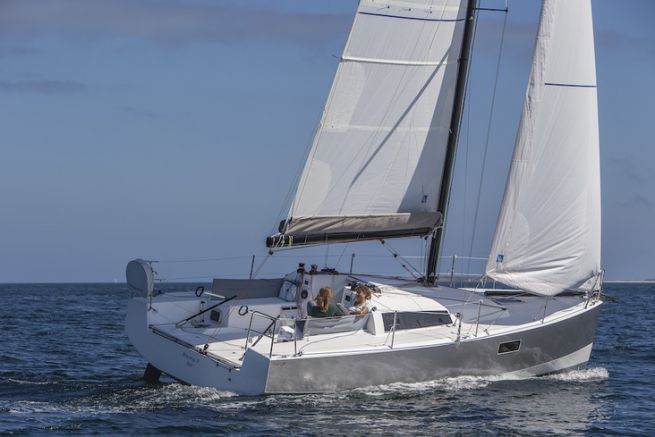
Whether cruising or regatta sailing, the vang is a mainsail adjustment that is sometimes misunderstood. For all those who wonder how to use the vang correctly, Bateaux.com gives you the keys.
The role of the boom vang
The vang is usually a hoist attached between the mast foot and the boom. Its variable length determines how high the boom can rise. It is therefore the vang that maintains the boom height when the mainsheet is let out. Upwind, the mainsheet only starts to lower the boom when it is above the mainsail carriage.
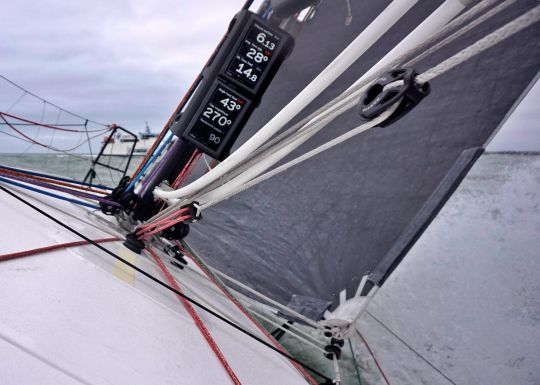
Why use bas??
The vang, together with the mainsheet, is one of two ways of controlling the boom height, which determines the twist.
If you do not use the downhaul (except in light winds), by shocking the sheet, the boom will rise and open the leech wide, releasing all the power from the top of the sail . This is ideal when the boat heels excessively and becomes too hot, but it is not the desired effect when power is still needed.
Not operating the boom vang also limits the ability to shock. If the top of the mainsail is very twisted, it will quickly press on the shrouds, preventing the boom from being shocked as much as desired, otherwise the whole bottom of the sail will start to tuck. But if the vang is taut enough, the moment when the top of the sail "wraps" around the shrouds will be delayed. In this way, the tension of the vang allows a greater range of adjustment.
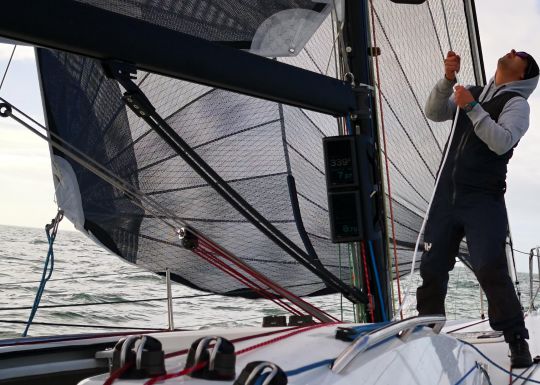
How do I use the bas??
We'll start by tucking in the mainsail with the sheet and then adjust the leech twist with the downhaul. It must be tensioned so that the top batten is more or less parallel to the boom. If it is too tight, the top batten will disappear behind the mainsail . To obtain the correct setting, simply shock the downhaul until the top link reappears.
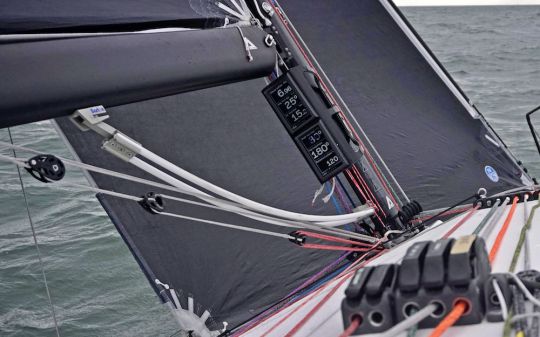
Is the downhaul indispensable on all bateaux??
There are, however, some exceptions with regard to the use of the vang. These concern multihulls and some very large monohulls. These boats have a particularly long mainsail track making the vang less necessary. Indeed, with this type of configuration, shocking the carriage makes it possible to regulate the power properly by playing on the incidence of the sail , while keeping the sheeting tension.
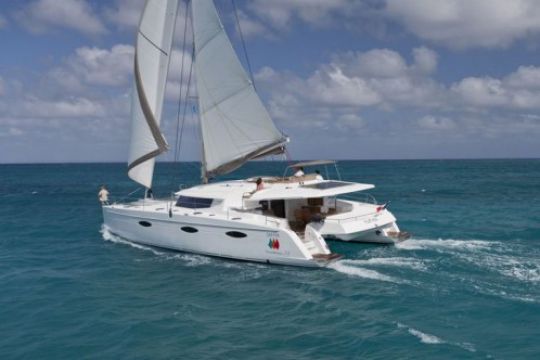
However, on these boats, the shrouds are often anchored well aft of the mast, which prevents the mainsheet from being easily shocked. A downhaul is therefore always useful, as it allows the boom to be shocked as much as possible before the rig becomes a problem. This is why almost all high-performance boats have a boom vang.
What's a vang for rigide??
Rigid downhauls allow the boom to be raised mechanically. For racers, this is particularly interesting in light winds, as the weight of the boom can stretch the leech when you would like to twist the sail . In addition, if the boat is not equipped with a lazy jack or topping lift, the downhaul will support the boom while reefing and folding the sail .
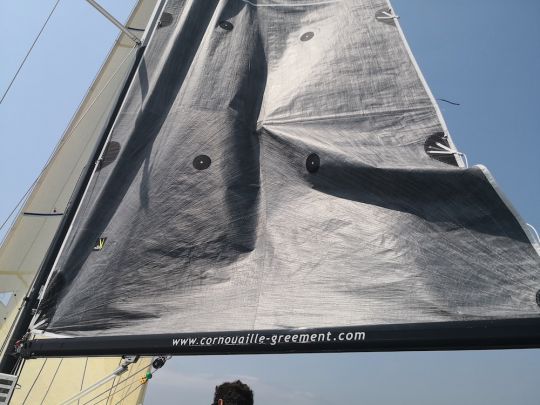
Using a Sailboat Boom Vang in Sailing
Konstantin Trubavin/Getty Images
- Top Artists
- Alternative Music
- Classical Music
- Country Music
- Rap & Hip Hop
- Rhythm & Blues
- World Music
- Heavy Metal
- Latin Music
A boom vang is used on a sailboat to pull down the boom on off-wind points of sail when the wind in the mainsail would lift the boom. Proper use of a boom vang helps keep the sail full and drawing well.
When a sailboat sails downwind, the mainsail is let out for best sail trim, and the boom is typically 50 to 80 degrees from the centerline out to the leeward side. Because of this angle, the mainsheet has a little downward pull on the boom, which freely rises and falls with wind changes and when the boat rolls on waves from behind. When the boom rises, the mainsail billows out, twists, and spills wind, then may snap back—over and over. This motion makes the sail less efficient.
A boom vang prevents this motion by pulling downward on the boom regardless of its position in relation to the centerline. A traditional block-and-tackle vang mounts between the base of the mast and mid-boom. The control line is typically led back to the cockpit, where pulling the line exerts force to pull the boom down.
A number of commercial rigid boom vangs are also available. This is essentially an adjustable pole that mounts similarly to hold down the boom. While more expensive than a block-and-tackle vang, rigid vangs have the added function of also holding the boom up when the mainsail is lowered, such that a topping lift is not needed.
How to Use a Boom Vang
When to tighten the vang:
- When sailing downwind on a broad reach or a run, tighten the vang to keep the boom down and minimize mainsail twist that spills air from the sail.
- If the boat does not have a traveler , which is used to pull the boom down on a beam reach, use the vang even on a beam reach (the wind directly over one side).
When to ease or release the vang to allow the boom to rise:
- When sailing downwind in light air, the mainsail generally has a better shape if the vang is not tight. Let the sail bag out some.
- When sailing downwind in a strong wind, ease the vang to depower the mainsail by allowing the boom to rise and the sail to spill air high up (mainsail “twist”). Bring in the mainsheet if needed to prevent chafing of the sail against the shrouds and spreaders.
- After dropping the mainsail, raise the boom to give more headroom in the cockpit.
Boom Vang as Preventer
If your boat lacks a boom preventer , an important piece of safety gear, it may be possible to improvise with the vang as a preventer when needed, if its lower connection can be easily released and moved forward of the mast.
- Safe Ways to Descend Cliffs and Mountains
- The Beginner's Guide to Skateboarding
- What Does Top 40 Mean?
- Should You Be Using a 16-Pound Bowling Ball?
- What Is Pop Music?
- Top 10 Top 40 and Pop Radio Stations
- Top Three Major Pop Record Labels
- Columbia Records Profile and History
- 10 of the Best Independent Pop Record Labels
- The Top 10 Best Black Eyed Peas Songs
- Top 10 Auto-Tune Songs
- Top 10 Songs Featured on '80s Film Soundtracks
- Top '80s Songs of American Arena Rock Band Journey
- 100 of the Best Pop Songs of All Time
× You are using an outdated browser. Please upgrade your browser to improve your experience.
We Ship Worldwide! | FREE SHIPPING! for US Continental orders over $99. Click for details.

Shopping Cart
Your cart is currently empty..
FREE SHIPPING! for US Continental orders over $99 click for details

A boom vang or kicking strap on a sailboat used to exert downward force on the boom and thus control the shape of the sail. Boom vangs helps control boom height which determines twist, or the shape of the mainsail leech during different wind conditions.
Sailboat Block & Tackle sets come with both of the blocks and a cleat to create a full boom vang system in one product. Simply select the purchase that you need and the working load based on your boat size.
If you are expecting a lot of light wind sailing and want to add some extra shape to your leech, add a rigid boom vang to hold up your boom so you don't have to. Instead of having to install and remove a topping lift, just keep a Sailboat Rigid Boom Vangs on your boom to keep it up even while you are gone.
Hydraulic Boom Vangs are used on larger sailboats and controlled by manual or electric hydraulic pumps.
Find Boom Vangs at MAURIPRO Sailing. We are your go-to online store for all sailboat equipment!
MAURIPRO Sailing, your direct access to Boom Vangs and all your other sailing and boating needs.
Copyright © 2024 MAURIPRO Sailing LLC.

- Forums New posts Unanswered threads Register Top Posts Email
- What's new New posts New Posts (legacy) Latest activity New media
- Media New media New comments
- Boat Info Downloads Weekly Quiz Topic FAQ 10000boatnames.com
- Classifieds Sell Your Boat Used Gear for Sale
- Parts General Marine Parts Hunter Beneteau Catalina MacGregor Oday
- Help Terms of Use Monday Mail Subscribe Monday Mail Unsubscribe
What to do with the topping lift?
- Thread starter smokey73
- Start date Thursday at 12:26 PM
- Forums for All Owners
- Ask All Sailors
I recently installed a rigid vang but still have the topping lift attached. The topping lift will need to be replaced if I decide to keep it. It is currently line/wire but if I replace it I would use it as a "spare halyard." . If you have installed a rigid boom vang and kept your topping lift, where/how to secure it? Thanks in advance
Most people who have a rigid vang, use the main halyard as a topping lift when not sailing. It also solves the halyard slapping problem.

SBO Weather and Forecasting Forum Jim & John
I secure my lift at the starboard shroud or at the mast depending on wind and banging, when not in use. I find it helpful as an emergency halyard, a lifting line, a support line of using the boom to crane a heavy weight on board. I have suspended tarps and play craft (dinghy or kayak) form the topping lift to get the thing aboard. A useful tool when available.
@jssailem I'm thinking it would be a good idea to convert the topping lift to an "emergency Halyard" and to have something to support the end of the mast for lifting, etc. I don't think I need the topping lift function with the rigid vang now but hate to give it up. I was thinking of just tying it off to the outer shroud to keep it out of the way. What type/size of line would you all suggest for this purpose?
I went to a rigid vang last year. I did not replace the TL (yet). I dont really need it, but using it as a spare halyard is a good idea. My sheave seems messed up, so I used the line as a new spinnaker halyard (which I needed). I have used my main halyard to support the boom while at the dock, but not really sure it is needed. I got lazy and just secured it to my shroud (which has a little cleat on it for the flag line up to the spreader). The rigid vang seems robust enough without needing the support from a TL. Greg
Tally Ho said: I went to a rigid vang last year. I did not replace the TL (yet). I dont really need it, but using it as a spare halyard is a good idea. My sheave seems messed up, so I used the line as a new spinnaker halyard (which I needed). I have used my main halyard to support the boom while at the dock, but not really sure it is needed. I got lazy and just secured it to my shroud (which has a little cleat on it for the flag line up to the spreader). The rigid vang seems robust enough without needing the support from a TL. Greg Click to expand
dlochner said: The rigid vang will support the mast, however, there are two issues to deal with, one is supporting the mast and the other is preventing or reducing the amount the boom swings while at dock or anchored. Since the rigid vang is spring loaded, it will cause the boom to bounce up and down, this wears on the vang and the shackles attaching the mainsheet to the traveler and boom. And, with all that movement, the vang may well squeak a lot. It is best to stabilize the boom, a topping lift or using the main halyard is one part. The other part is using the traveller, main sheet, and a third line to secure the boom. The less the boom moves, the less wear on the shackles connecting the traveller to the sheet. Notice the wear on the first and last shackles, it's not the best photo, but there is significant wear and reduction in strength. Left unchecked the wear can result in a catastrophic failure in the shackles leading to a wildly flailing boom. View attachment 226817 Click to expand
Size is dependent on the sheave. I suspect 5/16 to 7/16 is viable. I lean to 3/8th for feel. Indeed, on the shroud, it makes sense to store the line. Dacron double braid meets a servicable line at a budgetable price.
I have a rigid vang, but no topping lift. I secure the boom with the main halyard attached to the end of the mast and a steadying line run from the handrail to the main sheet tackle. That's a lot of weight to support the boom. If I were you, I would refresh the topping lift and use it as a boom support when moored FWIW.
A full strength topping lift makes a good safety line for mast climbing.
Rick D said: If I were you, I would refresh the topping lift and use it as a boom support when moored FWIW. Click to expand
smokey73 said: measure the size of the old rope Click to expand

- This site uses cookies to help personalise content, tailor your experience and to keep you logged in if you register. By continuing to use this site, you are consenting to our use of cookies. Accept Learn more…

- Sailboat Hardware
- Mainsail Handling
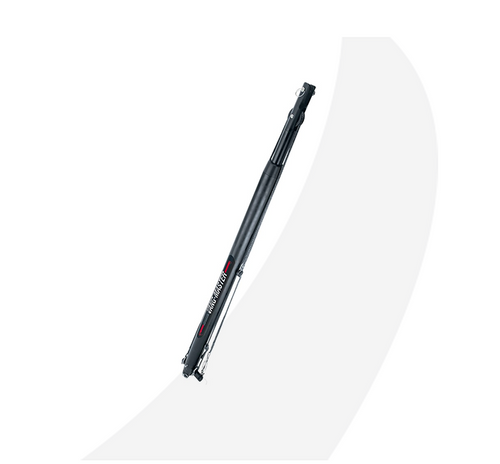
Vang Master Rigid Vang VM8 For Boats 45' To 56' (Closed 72" / Open 84")

Vang Master Rigid Vang VM7 For Boats 45' To 56' (Closed 60" / Open 72")

Vang Master Rigid Vang VM6 For Boats 35' To 46' (Closed 60" / Open 72")
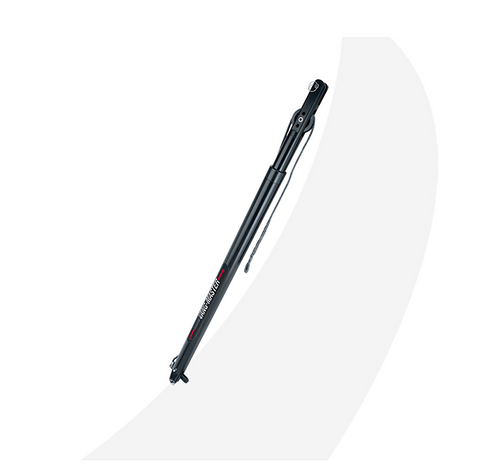
Vang Master Rigid Vang VM5 For Boats 35' To 46' (Closed 48" / Open 60")

Vang Master Rigid Vang VM4 For Boats 26' To 38' (closed 48" / open 58")

Vang Master Rigid Vang VM3 For Boats 26' To 38' (Closed 32" / Open 42")

Vang Master Rigid Vang VM2 For Boats 18' To 28' (closed 40" / open 50")
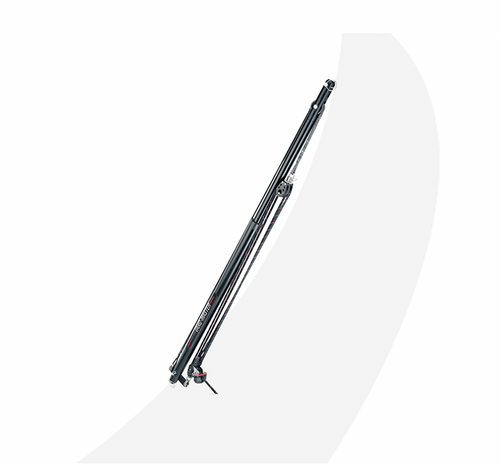
Vang Master Rigid Vang VM1 For Boats 18' To 28' (closed 28" / open 36")

Selden Gas Spring Kit (RodKicker 20/Super)

Selden Gas Spring Kit (RodKicker 30/Hard)

Selden Gas Spring Kit (RodKicker 10/Super)

Selden Gas Spring Kit (RodKicker 20/Hard)

Selden Gas Spring Kit (RodKicker 30/Normal )

Selden Gas Spring Kit (RodKicker 10/Hard)
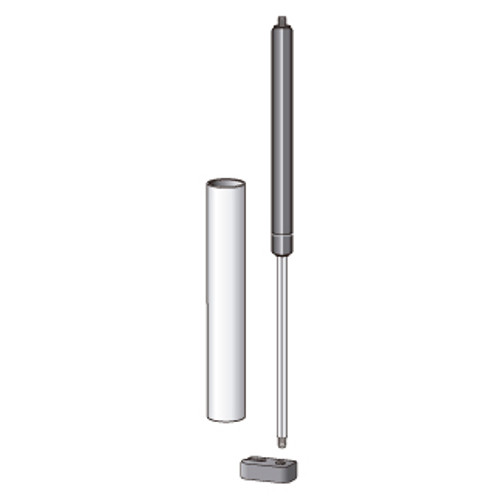
Selden Gas Spring Kit (RodKicker 20/Normal )

Selden Gas Spring Kit (RodKicker 10/Normal )

Selden Gas Spring Kit (RodKicker 05)

Schaefer Boom Vang, 4.1, 900 Lb (410kg) SWL

Schaefer Boom Vang, 4.1, 1000 Lb (450kg) SWL

Schaefer Boom Vang, 3.1, 1750 Lb (795kg) SWL

Boom Kicker vs Boom Vang: Which One Do You Need for Your Sailboat?
If you are a sailing enthusiast, you might have heard of two devices that can help you control the shape and angle of your mainsail: the boom kicker and the boom vang. But what are they exactly, and how do they differ from each other?
In this article, we will explain everything you need to know about these two sailboat accessories, and help you decide which one is best for your sailing needs.
What is a Boom Kicker?
A boom kicker is a modern mechanical device that pushes the boom up by one or more fiberglass rods. It is attached to the mast and the boom at an angle, and it works by flexing when the boom is pulled down by the mainsheet or the wind. This creates an upward force that lifts the boom and opens the leech (the back edge) of the sail.
A boom kicker has several benefits for sailors:
- It eliminates the need for a topping lift, which is a line that runs from the masthead to the end of the boom to support it when the sail is lowered. A topping lift can be annoying because it can get tangled with the sail or chafe against it.
- It improves sail performance in light wind conditions, by allowing more airflow over the sail and reducing drag.
- It makes reefing (reducing sail area) easier and safer, by keeping the boom stable and preventing it from hitting the deck or the crew.
- It works well with a block and tackles vang, which is a simple system of pulleys and lines that pulls the boom down to adjust the sail shape.
A boom kicker is easy to install and requires little maintenance. It is suitable for sailboats from 14 to 38 feet in length. It is also relatively inexpensive compared to other types of boom control devices.
What is a Boom Vang?
A boom vang is a set of blocks and lines or an adjustable pole that pulls the boom down and shapes the sail. It is also attached to the mast and the boom at an angle, but it works in the opposite way of a boom kicker. It counteracts the upward force of the wind and the mainsail by pulling the boom downward.
A boom vang has several benefits for sailors:
- It controls the twist of the sail, which is the difference in angle between the top and the bottom of the sail. By reducing twist, a boom vang makes the sail more efficient and responsive to wind changes.
- It prevents the boom from rising too high when sailing downwind, which can cause the sail to lose power and flap uncontrollably.
- It flattens the sail when sailing upwind, which reduces drag and increases speed.
- It works well with a rigid vang, which is a hydraulic or mechanical device that holds the boom in place without assistance. A rigid vang can also act as a topping lift when the sail is lowered.
A boom vang can be either a standard block and tackle system or a hydraulic or mechanical system. The latter is more advanced and offers more precise control, but it is also more expensive and complex to install and operate. A boom vang is common on most sailboats, especially those that exceed 30 feet in length.
Boom Kicker vs Boom Vang: Which One Do You Need?
Both a boom kicker and a boom vang can help you control your sail shape and angle, but they have different functions and advantages. Depending on your sailing style, preferences, and budget, you might need one or both of them for your sailboat.
Here are some factors to consider when choosing between a boom kicker and a boom vang:
- If you sail mostly in light wind conditions, or if you want to improve your sail performance and speed in such situations, a boom kicker might be a good option for you. It will help you open the leech of the sail and create more lift and power.
- If you sail mostly in strong wind conditions, or if you want to have more control over your sail twist and prevent excessive boom movement, a boom vang might be a good option for you. It will help you flatten the sail and reduce drag and instability.
- If you want to have both options available, you can use both a boom kicker and a boom vang on your sailboat. They can work together to give you the best of both worlds, as long as you adjust them properly according to the wind and sailing conditions. However, this might also add more complexity and cost to your sailboat setup.
- If you want to keep things simple and affordable, you can use neither a boom kicker nor a boom vang on your sailboat. You can rely on your mainsheet and other sail controls to adjust your sail shape and angle, but you might have less flexibility and efficiency in some situations.
A boom kicker and a boom vang are two devices that can help you control your sail shape and angle on your sailboat. They have different functions and advantages, and they can be used separately or together, depending on your sailing needs.
Both devices can improve your sail performance and safety, but they also add more complexity and cost to your sailboat setup.
Ultimately, the choice between a boom kicker and a boom vang depends on your personal preferences, sailing style, and budget. You might want to try both devices on your sailboat and see how they affect your sailing experience. You might also want to consult with other sailors or experts who have used them before and get their opinions and advice.
We hope this article has helped you understand the difference between a boom kicker and a boom vang, and how to choose the best one for your sailboat. Happy sailing!
Saiful Emon is the founder and editor of Sun Sea Skis , a sailing blog for adventure seekers. He loves sailing, traveling, and sharing his experiences with others. He also writes about fitness, wellness, business, and marketing in his spare time!
The Ultimate Guide to Choosing the Best 12v Vacuum for Your Boat
The best sailboats to live on for every budget, lifestyle, and experience level, leave a comment cancel reply.
Save my name, email, and website in this browser for the next time I comment.

Please verify you are a human
Access to this page has been denied because we believe you are using automation tools to browse the website.
This may happen as a result of the following:
- Javascript is disabled or blocked by an extension (ad blockers for example)
- Your browser does not support cookies
Please make sure that Javascript and cookies are enabled on your browser and that you are not blocking them from loading.
Reference ID: cb026159-5da2-11ef-b72c-c369b7414775
Powered by PerimeterX , Inc.
Free Shipping Over $99 - 366 Day Returns - Expert Advice

- Call Us +1-503-285-5536
- Sign in & Register
- Recently Viewed
- One Design Parts
- ILCA / Laser Parts
Laser / ILCA Boom Vang Rigging & Parts
Regain control with an upgraded boom vang or replacement vang parts or line for your Laser / ILCA sailboat from the experts at West Coast Sailing. We offer the latest 16:1 class legal vang, the classic 3:1 vang, replica options, pre-cut line, and all the recommended blocks, pins, and fittings.
- Qty in Cart

Laser / ILCA Vang Complete TecPRO (Allen Vang Block)

Laser / ILCA Vang Control PRO

Laser / ILCA Vang Complete TecPRO (Harken Vang Block)
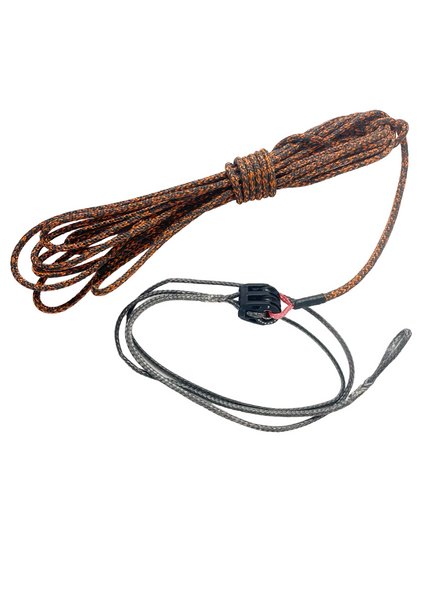
Laser / ILCA Vang Control TecPRO

Laser/ILCA 30mm Extreme High Load Vang Block (Allen)

Ronstan ILCA Vang Key (Curved)

Ronstan ILCA High Load Vang Block (No Key)

Ronstan ILCA High Load Vang Block

ILCA Vang Upgrade Harken XD Base

ILCA Vang Key (Updated)

ILCA Laser Vang Upgrade Harken
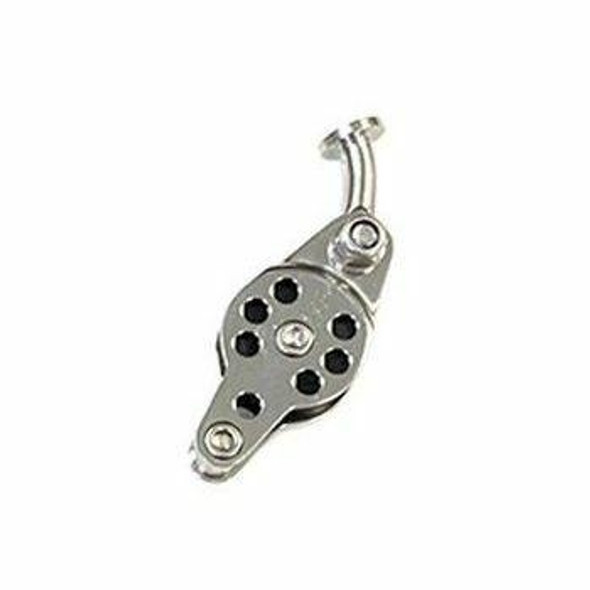
Laser / ILCA Vang Upper Block w/ Key

Harken 19mm Bullseye Fairlead (ILCA Vang Base)

Laser Vang Upgrade 15:1 (Allen)

Laser Lower Vang Block (Allen)

Laser Vang Key (Nautos)
- Total: items /
- Add all to cart
Adding your products to cart
Race / 16:1 Boom Vang System

This is the current vang set up found on most modern Laser / ILCA sailboats, offering a powerful 16:1 cascade system. It features a vang base unit, double block with becket in the center, and a vang block with key at the top end, using a length of 4mm or 5mm control line with a Dyneema/Spectra primary line.
Classic / 3:1 Boom Vang System

This is the vang assembly used on Laser sailboats until 2001. It is a simple 3:1 purchase, using a jam block at the base with a simple turning block with key at the top and a 10 foot length of control line. This set up is great for the casual sailor.
Subscribe To Our Newsletter
Sign up for our newsletter to receive exclusive discounts, new product announcements, and upcoming sales.
- Print This Page
- Text Size
- Scroll To Top

Welcome to the MC Sailing Association

Upcoming Events
2024 regatta results.


“HISTORY OF THE SCOW” Film Proposal Woody Woodruff has been sailing scows a long time and is using his talents as a film producer to make a documentary film on scows: The Project Donate Here

Notice of Election & Annual Membership Meeting
As part of its annual rotation, the Board seeks nominations of candidates to fill the positions of retiring members of the Board of Governors. Nominees must be current MCSA members and available to actively serve a three year term of office beginning January 1, 2025. The elected individuals will fill the expiring term of Scott Slocum, Scott Harestad, & Natalie Sinn. When contemplating prospective nominees, consider the value of maintaining a Board balance in sailing, administrative, and leadership skill sets as well as a geographical representation of MCSA members.
The following member has accepted a nomination to fill one of the three open positions of the retiring Board members and will be placed on the ballot for a verbal vote: The following is a list of the current Board members whose terms expire on December 31st of the year indicated:
Natalie Sinn - Minnetonka YC, MN (2025) Dana Nelson - Club de Voile Deux-Montagnes, CN (2025)
Kevin Neal - Florida (2025) Christy Will - Beulah YC, WI (2026) Matt Fisher - Hoover SC, OH (2026) Sean Bradley - Barnegat Bay YR Assoc, NJ, (2026)- Commodore Chris Kubicek - Lake Beulah YC, WI (2028) - Vice Commodore Scott Harestad - Spring Lake YC, MI (2024) - Rear Commodore
The election will be held during the Annual Membership Meeting to be held at the MCSA National Championship August 21-24, Lake Geneva YC, WI. Inquiries should be submitted to Chris Kubicek at [email protected]
© MC Sailing Association, Inc. 2024. All Rights Reserved.

COMMENTS
A boom vang is a set of blocks and lines or an adjustable pole used to pull the boom down and shape the sail.
The vang allows vertical adjustment of the boom, and is an extremely important tool to shape the main for speed. Tension the vang to tighten the leech, flatten the sail and bend the mast. Cruisers use the vang to keep the boom from rising when sailing downwind and abraiding the main.
A boom vang (US) or kicking strap (UK) (often shortened to "vang" or "kicker") is a line or piston system on a sailboat used to exert downward force on the boom and thus control the shape of the sail. The Collins English Dictionary defines it as "A rope or tackle extended from the boom of a fore-and-aft mainsail to a deck fitting of a vessel ...
The boom vang provides vertical control of the boom. It is a very useful control in many ways. Some of the functions a vang may perform include the following: Twist control for the mainsail: Downwind, the vang prevents the top of the main from twisting excessively, which causes the upper section of the sail to be under-trimmed or luffing, and ...
To install a boom vang on a C-22 or similar sailboat: 1. The vang should be installed at a 45 degree angle between the mast and boom. Measure the height of the top of the boom above the cabin roof with the mainsail at full hoist. For a Catalina 22, it should be 39″. 2.
The vang is also an excellent tool for in-boom furling systems and even as a backup preventer, as it can help maintain boom angle and height. Because many in-boom furling systems require a specific boom angle, the vang is a perfect way to help hold the boom in place when taking down or putting up your sails, minimizing damage and flogging.
This size Ocean Vang retails for $279, which includes the control line, but not the brackets for the mast ($39) or boom ($42). The vang carries a one-year warranty. Conclusions. For cruising sailors, it's most important that a rigid vang works to support the boom and secondarily to trim the mainsail.
Absolutely! The boom vang can be a misunderstood sail control. It takes over the job of pulling down on the boom once the mainsheet is eased. Upwind, the mainsheet pulls down as soon as the boom is over the traveler. Controlling the boom height determines twist, or the shape of the mainsail leech. If you don't use the boom vang in all but the ...
The Boom Vang, in its simplest form, is a block and tackle arranged in such a fashion that it applies downward force (also upward force, see rigid vang) to the boom. This will allow the sailor to control the tension of the leech at all points of sail, regardless of the boom's sheet tension. Although more purchase may be necessary, typically ...
The vang, together with the mainsheet, is one of two ways of controlling the boom height, which determines the twist. If you do not use the downhaul (except in light winds), by shocking the sheet, the boom will rise and open the leech wide, releasing all the power from the top of the sail. This is ideal when the boat heels excessively and ...
A boom vang is a line or piston system that exerts downward force on the boom, controlling the shape of the sail and enhancing overall sailing efficiency. At Fisheries Supply, we offer a wide range of rigid boom vangs from top brands, ensuring you find the perfect solution for your sailboat. Our selection includes the renowned Rodkicker from ...
Proper use of a boom vang helps keep the sail full and drawing well. Learn how to use a traditional block-and-tackle or rigid boom vang.
Boom Vangs A boom vang or kicking strap on a sailboat used to exert downward force on the boom and thus control the shape of the sail. Boom vangs helps control boom height which determines twist, or the shape of the mainsail leech during different wind conditions.
Since the rigid vang is spring loaded, it will cause the boom to bounce up and down, this wears on the vang and the shackles attaching the mainsheet to the traveler and boom. And, with all that movement, the vang may well squeak a lot. It is best to stabilize the boom, a topping lift or using the main halyard is one part.
Boom vangs control mainsail leech tension independently of the mainsheet so you can control sail twist. They're particularly effective off the wind, when the pull of the sheet is primarily horizontal, because they prevent the boom from lifting and spilling the wind. We offer four vangs to fit most dinghies and racer-cruisers.
Boom vangs from Vela at the best price. One design or custom built available. Boomkicker, Vang Master, and Schaefer. The best boomvangs from Vela.
A boom kicker pushes the boom up and opens the leech of the sail, which is beneficial in light wind conditions. A boom vang pulls the boom down and flattens the sail, which is beneficial in strong wind conditions. Both devices can improve your sail performance and safety, but they also add more complexity and cost to your sailboat setup.
Boat vangs generally consist of a block and tackle system designed to pull the boom down. Rigid vangs also include block and tackle systems to pull the boom down, but also hold the boom up in place of a topping lift. Boomkickers also act as boom supports and eliminate the need for a topping lift. They are designed for installation on boats that ...
Regain control with an upgraded boom vang or replacement vang parts or line for your Laser sailboat from the experts at West Coast Sailing. We offer the latest 16:1 class legal vang, the classic 3:1 vang, replica options, pre-cut line, and all the recommended blocks, pins, and fittings.
The boat must weigh at least 671 kg (1,479 lb) with a maximum total sail area of 26.5 m 2 (285 sq ft). [ 3][ 2][ 1] The Star class pioneered an unusual circular boom vang track, which allows the vang to effectively hold the boom down even when the boom is turned far outboard on a downwind run.
Welcome to the MC Sailing Association. The MC Sailing Association originally formed in Shreveport LA, 1971. Since then, the MC class has grown to be one of the top one-design sailboat racing classes in North America. The scow design maximizes speed yet provides unmatched stability. There are more than 113 active fleets nationwide.
RE: Tuning IOM - How to. Quote: ORIGINAL: mfr02. I tend to the view that you start with getting the leading edges straight (assuming a straight mast), and adjusting the leeches through the vang in the case of the main, and the leech line in the case of the fore. The objective is to allow the right amount of shape while preventing the roach from ...
What is a Sailboat Boom Vang? Last Updated by. Daniel Wade. June 15, 2022. A boom vang is a set of blocks and lines or an adjustable pole used to pull the boom down and shape the